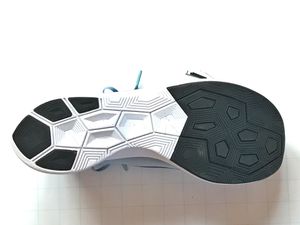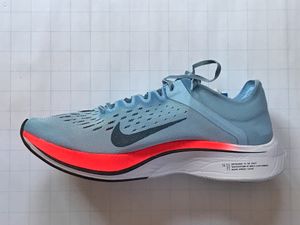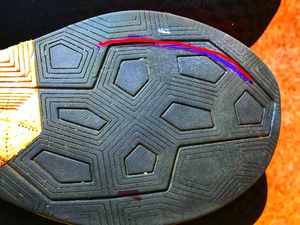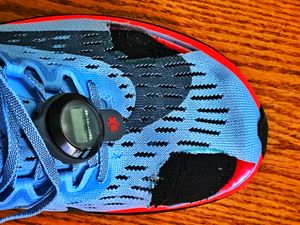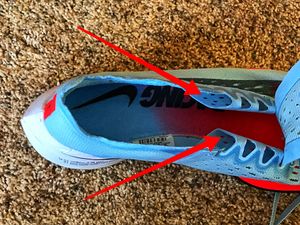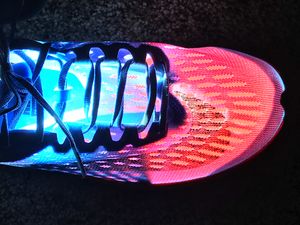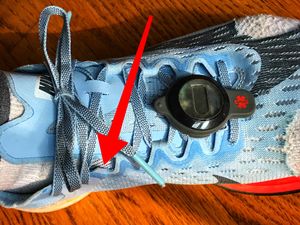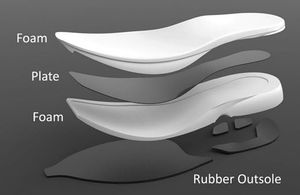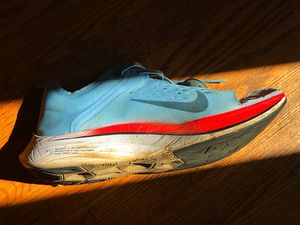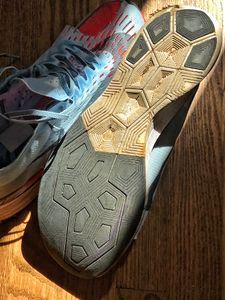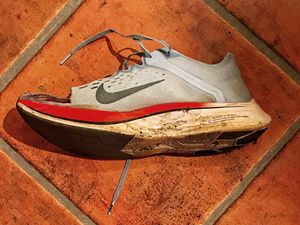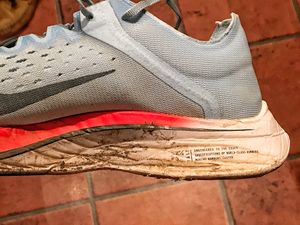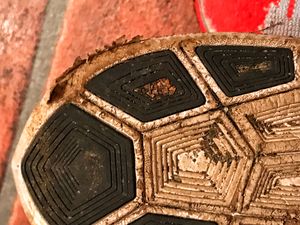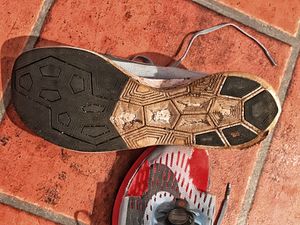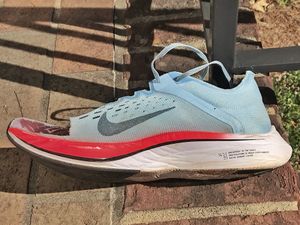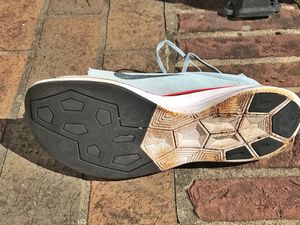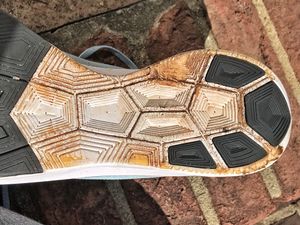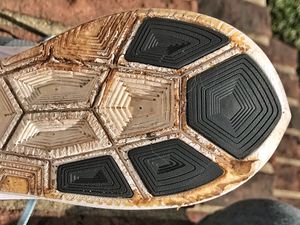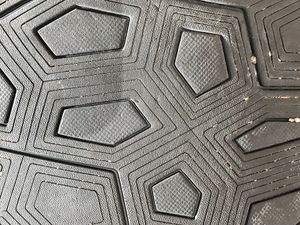Difference between revisions of "Nike Vaporfly 4%"
User:Fellrnr (User talk:Fellrnr | contribs) |
User:Fellrnr (User talk:Fellrnr | contribs) m (comment: batch update) |
||
| Line 1: | Line 1: | ||
{{DISPLAYTITLE:Nike Vaporfly 4% Review}} | {{DISPLAYTITLE:Nike Vaporfly 4% Review}} | ||
The Nike Vaporfly 4% is a much-hyped shoe, which is based on the shoes Nike developed for their attempt to break the 2-hour marathon. It's an expensive shoe, retailing for $250, and even at that price it's hard to find. There are rumors that Nike are restricting supplies to drive up interest. The shoe is unusual in that it has a carbon fiber plate running through the midsole. Given all the hype, I was not expecting much from the Vaporfly 4%, but there are aspects to the shoe that have really impressed me. I'd say it's a mixture of the awesome and awful, though not in quite the ways I expected. | The Nike Vaporfly 4% is a much-hyped shoe, which is based on the shoes Nike developed for their attempt to break the 2-hour marathon. It's an expensive shoe, retailing for $250, and even at that price it's hard to find. There are rumors that Nike are restricting supplies to drive up interest. The shoe is unusual in that it has a carbon fiber plate running through the midsole. Given all the hype, I was not expecting much from the Vaporfly 4%, but there are aspects to the shoe that have really impressed me. I'd say it's a mixture of the awesome and awful, though not in quite the ways I expected. | ||
| − | * The shoe has remarkable cushioning for its weight, with my measurements putting it close to the top of the table. I ran with a [[Hoka Clayton]] on one foot and the Vaporfly on the other and the Clayton felt hard and dead by comparison. The Vaporfly uses a new type of foam made of Pebax, a compound that has previously been used in harder materials like Mizuno's Wave Plate. It will be interesting to see this foam in other shoes, especially something closer to a "racing flat". There is a rumored Reebok | + | * The shoe has remarkable cushioning for its weight, with my measurements putting it close to the top of the table. I ran with a [[Hoka Clayton]] on one foot and the Vaporfly on the other and the Clayton felt hard and dead by comparison. The Vaporfly uses a new type of foam made of Pebax, a compound that has previously been used in harder materials like Mizuno's Wave Plate. It will be interesting to see this foam in other shoes, especially something closer to a "racing flat". There is a rumored Reebok Floatride Racer using Pebax foam, but no details, and I've reviewed the [[Reebok Floatride Run]] which uses Pebax. |
* When you wear the shoe, it has an amazing amount of bounce. It's far more than you get in TPU shoes like the [[Altra Escalante]], and feels like there's a spring under your foot. It seems like the carbon fiber plate is acting more as a spring for the rear of the shoe than for toe off. This bounce is immediately obvious, even walking around, and feels different to every other shoe I've tried. Even at the end of a marathon length run the bounce is noticeable and helped me keep up the pace. (Check out my review of the carbon fiber [[VKTRY Insoles]] for comparison.) | * When you wear the shoe, it has an amazing amount of bounce. It's far more than you get in TPU shoes like the [[Altra Escalante]], and feels like there's a spring under your foot. It seems like the carbon fiber plate is acting more as a spring for the rear of the shoe than for toe off. This bounce is immediately obvious, even walking around, and feels different to every other shoe I've tried. Even at the end of a marathon length run the bounce is noticeable and helped me keep up the pace. (Check out my review of the carbon fiber [[VKTRY Insoles]] for comparison.) | ||
* I couldn't detect much difference in toe off from any other shoe, which was disappointing. The forefoot is quite stiff compared with other shoes, but given the forces involved at toe off, this doesn't seem to be enough to make much difference. Of course, a tiny difference in efficiency won't be noticeable immediately, but could make quite a difference to your finish time. | * I couldn't detect much difference in toe off from any other shoe, which was disappointing. The forefoot is quite stiff compared with other shoes, but given the forces involved at toe off, this doesn't seem to be enough to make much difference. Of course, a tiny difference in efficiency won't be noticeable immediately, but could make quite a difference to your finish time. | ||
Latest revision as of 09:57, 23 January 2018
The Nike Vaporfly 4% is a much-hyped shoe, which is based on the shoes Nike developed for their attempt to break the 2-hour marathon. It's an expensive shoe, retailing for $250, and even at that price it's hard to find. There are rumors that Nike are restricting supplies to drive up interest. The shoe is unusual in that it has a carbon fiber plate running through the midsole. Given all the hype, I was not expecting much from the Vaporfly 4%, but there are aspects to the shoe that have really impressed me. I'd say it's a mixture of the awesome and awful, though not in quite the ways I expected.
- The shoe has remarkable cushioning for its weight, with my measurements putting it close to the top of the table. I ran with a Hoka Clayton on one foot and the Vaporfly on the other and the Clayton felt hard and dead by comparison. The Vaporfly uses a new type of foam made of Pebax, a compound that has previously been used in harder materials like Mizuno's Wave Plate. It will be interesting to see this foam in other shoes, especially something closer to a "racing flat". There is a rumored Reebok Floatride Racer using Pebax foam, but no details, and I've reviewed the Reebok Floatride Run which uses Pebax.
- When you wear the shoe, it has an amazing amount of bounce. It's far more than you get in TPU shoes like the Altra Escalante, and feels like there's a spring under your foot. It seems like the carbon fiber plate is acting more as a spring for the rear of the shoe than for toe off. This bounce is immediately obvious, even walking around, and feels different to every other shoe I've tried. Even at the end of a marathon length run the bounce is noticeable and helped me keep up the pace. (Check out my review of the carbon fiber VKTRY Insoles for comparison.)
- I couldn't detect much difference in toe off from any other shoe, which was disappointing. The forefoot is quite stiff compared with other shoes, but given the forces involved at toe off, this doesn't seem to be enough to make much difference. Of course, a tiny difference in efficiency won't be noticeable immediately, but could make quite a difference to your finish time.
- When I ran it the Vaporfly using a pure forefoot landing (without any heel contact) I found the Vaporfly lost all the bounce and felt very dead. (If you're a pure forefoot runner, I'd look elsewhere.)
- The Vaporfly claims a 10mm drop, and my measurements showed 12mm, but this is reduced to 8mm when loaded. This is normally way more than I can tolerate, but I had few problems in the Vaporfly.
- The rear of the shoe feels quite unstable, rather like I'm on a balance foam mat rather than a shoe. It's like the shoe is only supporting me heel directly under the ball, which is rather disconcerting.
- The forefoot of the shoe is even worse, with the area under the ball of the foot lower and softer than the rest of the forefoot. This means that the shoe forces your foot to pronate more than it naturally would. I measured the area under the ball of the foot as 1-2mm lower than the rest of the forefoot under load. I suspect that the carbon fiber plate does not extend under the ball of the foot for some reason, though it's hard to prove. If I try bending the forefoot of the shoe with my hand the area under the ball of the foot doesn't seem to be as stiff.
- I found that I had a tendon pain in my ankle as my calf muscle subconsciously attempted to limit my foot rotation. I had to consciously relax and allow my foot to rotate in, which is rather disconcerting to say the least. Normally I only get this with worn out shoes. After an adaptation period of sore ankles, I found my legs adapted fine to the additional stress, though I've always been aware of the instability.
- Initially, the outsole had surprisingly little grip, feeling slick and unsure on anything that isn't a firm surface. After I'd put some miles on them, the grip seemed to improve and was remarkably good, except on gritty asphalt where the grit acts like marbles.
- I found the toe box was not as bad as I expected, though running 20 miles without cutting open the toe box resulted in a minor blister.
Overall, I feel like I'm faster in the Vaporfly than other shoes by a noticeable amount, which is quite astonishing. This is hard to confirm, but my Heart Rate and perceived exertion seem noticeably lower for a given pace and Stryd Power Estimate. On the other hand, I feel like the Vaporfly has a real risk of injury, adding stress on to ankles and knees. After many hours of consideration, and hundreds of miles of running, I've rated the Vaporfly as "best of the best" in spite of its many flaws. It's expensive, almost impossible to find, and risks injury, but it's just so good that I think if you can handle the extra stress, it's worth it. These reviews are not being maintained. If you want trustworthy and detailed reviews, check out Run Repeat Shoe Reviews. If I'd continued doing running shoe reviews, I'd want to produce a site like run repeat. I used The Science of Running Shoes as the basis of how I tested running shoes and what you should look for in a running shoe.
Contents
[hide]1 Characteristics
- Cushioning . The cushioning of the Vaporfly is impressive, but the numbers on my comparison chart below don't really convey the level of shock absorption and bounce. One way of conveying this is that the Vaporfly is to a Hoka what a Hoka is to a racing flat. This sense of bounce is immediately obvious when you first put the Vaporfly on. You can tell the difference just standing in them, and the difference when walking can be a little disconcerting. I've found the bounce is helpful to me even at the end of a marathon length run, when normally fatigue makes any shoe seem less cushioned than at the start. This cushioning is not without its issues however, and the Vaporfly feels quite unstable. It's like your foot is balancing on a ball rather than a block of foam. The height of the sole exacerbates this instability, and taking fast, tight corners requires some care. The instability also creates extra stress on my ankles, and I've found some discomfort around the Achilles, as well as tender calves.
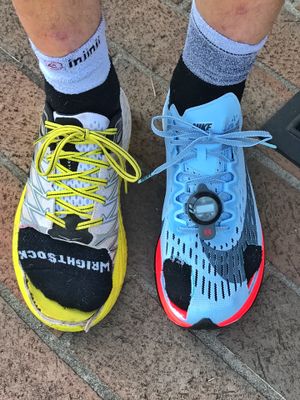 Comparing the Vaporfly with the Hoka Clayton.
Comparing the Vaporfly with the Hoka Clayton. - Drop. Normally the massive drop of the Vaporfly, which I measured at 12mm, would cause me all sorts of issues when running, but I've got on surprisingly well with it. Part of this might be that the 12mm drop is reduced to 8mm when worn, and might be even less under the impact of running. I have had issues with my heel scraping during the float phase of my stride, but this is not as bad as other shoes. If I'd have had to guess at the drop (something I can generally do fairly well), I'd have put the drop at about 4-5mm. That's more than I'd like, but not problematic.
- Structure. The structure of the Vaporfly comes from its carbon fiber plate. There doesn't appear to be any attempt to reduce pronation, and the carbon fiber plate actually seems to actively increase pronation. I have not dissected my pair, but it feels very much like the carbon fiber plate doesn't extend under the ball of the foot. Instead, it seems like the plate runs the full length of the shoe, but only under the four outside metatarsal bones. Towards the end of a marathon length training run the edge of the plate can become quite uncomfortable, and I've had some soreness from it. Under load, the ball of the foot is lower than the other four metatarsal heads, something I normally find when a shoe is worn out due to the midsole foam collapsing.
- Flexibility. The Vaporfly's carbon fiber plate obviously reduces its flexibility. It's far from the least flexible shoe I've tested, but the carbon fiber plate makes it more of a spring, where most maximally cushioned shoes tend to be rigid. As noted above, I'm surprised how little I noticed the toe off spring. I've tested the VKTRY Insoles, which is an aftermarket carbon fiber plate that you can put in existing shoes. I found the benefits of VKTRY were hard to notice, but it's hard to detect things that can make a significant difference to your running performance. After all, 1% difference in running economy can be the difference between success and failure in a race, but I doubt you'd ever be able to perceive the change. The carbon fiber plate in the Vaporfly is fairly deep in the midsole, so there are no issues with it feeling hard under foot, which is a major downside to the VKTRY insole.
- Outsole. You can see the hard rubber outsole as the black areas on the sole of the Vaporfly. The outsole seems to be fairly hardwearing, and after some miles it's fairly grippy. It's not as good on gritty asphalt as the plastic nubs you get on Japanese racing shoes, but it's better than I expected. The outsole is placed so that most of the contact areas are protected, but there's still a lot of exposed midsole that's softer.
- Shape. The Vaporfly shape doesn't match the human foot, so the toe box compresses the toes. I found the Vaporfly is not as bad as most running shoes, but it did give me toe blisters until I cut open the toe box. (I recommend cutting open the toe box of virtually all running shoes, with the exception of a few shoes like some Altra shoes. When you have some worn out shoes, you should try cutting open the toe box. I've found that it's a big improvement, allowing my toes to move naturally and engage for toe off, as well as reducing the possibility of blisters.).
- Upper. The upper is nicely breathable and light weight. There's no padding in the upper except for around the ankle opening, though the upper material doubles over to support the laces. I've found the upper quite comfortable up to marathon distance (I've not run further than that in them so far.)
- Tongue. The tongue is a traditional style, without connections to the upper except at the base. It's thin and unpadded, but comfortable and I had no issues with pressure from the laces. I did find that the tongue tends to slip to the side a little, which is an annoyance, but nothing more.
- Lacing. The laces work well and remained tied.
- Heel Counter. The Vaporfly has no heel counter, just the stiffness of the upper to keep it's shape.
2 Other Breaking-2 Shoes
Nike's highly publicized attempt to break the 2-hour marathon was documented in the National Geographic "breaking 2" (freely available on youtube.com). That failed attempt used the Nike Vaporfly Elite, a shoe you can't buy. This Vaporfly uses the same ZoomX foam and a carbon fiber plate in the midsole as the Vaporfly Elite. There is also the Nike Zoom Fly which looks superficially identical to the Vaporfly, but is radically different and vastly inferior.
3 Is It Really Faster?
A study "A Comparison of the Energetic Cost of Running in Marathon Racing Shoes" looked at the performance of the similar prototype shoe to the Nike Vaporfly. This study included researchers working for Nike, as well as the University of Colorado, and it used a shoe that not actually the Vaporfly, so use caution in interpreting the study. The picture below gives some insight to the construction of the Vaporfly, but also suggests some differences from the prototype which appears to have a full with carbon fiber plate.
The prototype was compared with the Nike Zoom Streak 6 (NS) and the Adidas adizero Adios BOOST 2 (AB). It's nice to see that they disclosed the actual shoes they compare it to. The researchers added small weights to the two Nike shoes so they were weight matched with the Adidas. A mechanical check showed that the prototype shoe was twice as well cushioned as either of the other shoes, deforming 11.9mm versus 6.1 and 5.9 mm. They prototype also had more bounce, returning 87.0% compared with 75.9% for the Adidas and 65.5% for the Steak. The study then compared the Running Economy of sixteen male high-level runners in the three different shoes. The runners have a VO2max of ~72, which is translates to a marathon time of about 2:20. They tested them at 14 kph (6:53 min/mile), 16 kph (6:02 min/mile), and 18 kph (5:22 min/mile), all below the Lactate Threshold of the runners (4 mmol/l, which is good enough for this study.) The running economy of the prototype shoe was 4% better than either of the other two shoes, which had similar running economy. The study noted that the prototype shoe was slightly better for rear foot landing runners (~4.7%) than the forefoot landing (~3.6%).
4 Update After 100 Miles
Normally, I would give an update on a pair of running shoes once I'd put rather miles on them. However, the vapor fly as something of a reputation for fragility, so I wanted to track its progress carefully. Even after this short distance, there is some evidence of the foam midsole braking down. If you look at the profile picture below, you can see some increases in the midsole appearing, and there is a noticeable indent under the ball of my foot. On the underside of the shoe, there is only a small amount of abrasion on the exposed foam. The hard rubber outsole (the black areas) are completely unchanged, suggesting that they are surprisingly hard wearing. The grip has improved over the course of the 100 miles. The main abrasion area on the exposed foam midsole is on the outside rear edge, where I occasionally catch my heel on steep descents. It should be noted that my running biomechanics are fairly efficient, and I'm typically quite gentle on my shoes. The upper is doing fine, even where I've cut open the toe box.
5 Update After 200 Miles
Over the last hundred miles I've come to really enjoy running in the Vaporfly. I've found my calf muscles have adapted reasonably well, and I've not had the ankle issues that I was fearing. My plantar fascia has been a little irritated, but nothing excessive. The foam midsole has continued to collapse, which is made the lack of support under the first metatarsal rather noticeable, and I can feel where the carbon fiber plate ends a little more distinctly. As you can see from the photos below, there's been remarkably little wear on the rubber outsole, and the exposed midsole is holding up pretty well. The Vaporfly is an awesome shoe for faster runs, but it does surprisingly well for Long Slow Distance. So, my initial thoughts of "awesome but awful" remain, and I'd still urge an abundance of caution as I think there is a significant injury risk to the vapor fly, but if you can handle the stress, and you can find a way to obtain a pair, I highly recommend it.
6 Update After 300 Miles
Another 300 miles have gone by quickly and pleasantly. The degradation of the Vaporfly has continued slowly, without any "falling off the cliff" that sometimes occurs. I've cleaned up the shoes a little more carefully for the photos below, and you can see that the midsole has a thin white plastic layer over the slightly more yellowed foam. The level of abrasion of the exposed midsole is surprisingly limited given the mileage. The black rubber outsole is even less abraded, and most of it looks entirely untouched. The midsole foam continues to collapse, but the collapse under the carbon fiber plate is far less than it would be without it. This means that the margin around the outside of the shoe where there's no plate is noticeably lower, and the area under the ball of my foot is depressed several millimeters. It's interesting when I swap back to "normal" running shoes. The extra support under the ball of the foot with fresh shoes is dramatic and feels really weird, but the big difference is how much I miss the spring of the Vaporfly.
7 A Comparison with other Recommended Shoes
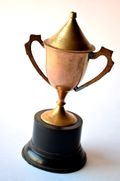
| If you're looking for "the best of the best" running shoe, here are my top picks. Of course, the answer will depend a little on what you're looking for, so I have recommendations for various categories.
|
For a more detailed on running shoes see the Recommendations for Best Running Shoes. This table lists the key attributes of What to Look for in Running Shoes. For more detailed information, on the shoes see detailed shoe comparison.
|
Full Review ▼ |
Brand ▼ | Name | Rating | Recommended price |
Benefit | Weight (oz) |
Penalty (sec/mile) |
Forefoot Thickness |
Heel Thickness |
Loaded Drop mm |
Cushioning | Flexibility |
|---|---|---|---|---|---|---|---|---|---|---|---|---|
| Saucony Type A Review | Saucony | A/A7 | Recommended | $100 | 6.4 | 6.7 | 12.1 | 19 | 22 | 1 | 4.3 | 7 |
| Saucony Type A6 Review | Saucony | A6 | Highly Recommended | $100 | 8.2 | 6.1 | 9.5 | 17 | 21 | 4 | 5.0 | 7 |
| Saucony Type A8 Review | Saucony | A8 | Highly Recommended | $90 | 7.5 | 6.2 | 9.7 | 19 | 20 | -1 | 4.7 | 7 |
| Adidas Adios Boost 2 Review | Adidas | Adios | Worth considering | $140 | 4.7 | 8.6 | 13.4 | 17 | 27 | 11 | 4.0 | 6 |
| Hoka Bondi 5 Review | Hoka | Bondi | Recommended | $150 | 6.1 | 11.6 | 18.1 | 38 | 42 | 5 | 7.1 | 2 |
| Hoka Clayton 2 Review | Hoka | Clayton2 | Highly Recommended | $150 | 9.1 | 8.3 | 12.9 | 23 | 28 | 1 | 7.5 | 5 |
| Hoka Clifton 4 Review | Hoka | Clifton4 | Worth considering | $130 | 7.7 | 9.3 | 14.5 | 30 | 35 | 10 | 7.2 | 3 |
| ON Cloudflash Review | On Cloud | Cloudflash | Worth considering | $180 | 4.4 | 8.3 | 14.6 | 19 | 26 | 7 | 3.7 | 6 |
| On Cloudracer Review | On Cloud | Cloudracer | Worth considering | $130 | 5.7 | 8.2 | 12.8 | 19 | 27 | 5 | 4.7 | 7 |
| ON Cloud X Review | On Cloud | CloudX | Not recommended | $140 | 4.5 | 8.3 | 16.3 | 21 | 27 | 7 | 3.8 | 7 |
| Mizuno Wave Cruise Review | Mizuno | Cruise | Worth considering | $120 | 6.6 | 5.9 | 12.5 | 17 | 20 | 7 | 3.9 | 6 |
| Newton Distance IV Review | Newton | Distance | Worth considering | $155 | 7.5 | 9.1 | 14.2 | 26 | 31 | 3 | 6.8 | 5 |
| Asics Gel DS Racer 10 Review | Asics | DS Racer | Worth considering | $110 | 8.2 | 7.0 | 10.9 | 21 | 26 | 6 | 5.8 | 5 |
| Altra Duo Review | Altra | Duo | Recommended | $130 | 6.0 | 8.4 | 13.1 | 29 | 29 | 1 | 5.0 | 5 |
| Mizuno Wave Ekiden 8 Review | Mizuno | Ekiden | Worth considering | $115 | 5.7 | 5.7 | 14.6 | 13 | 18 | 6 | 3.2 | 8 |
| Saucony Endorphin 2 Review | Saucony | Endorphin 2 | Worth considering | $115 | 8.0 | 5.1 | 9.6 | 15 | 13 | -1 | 4.1 | 8 |
| Adidas Energy Boost Review | Adidas | Energy | Worth considering | $160 | 7.2 | 10.0 | 15.6 | 20 | 30 | 7 | 7.2 | 5 |
| Altra Escalante Review | Altra | Escalante | Best of the Best | $130 | 9.1 | 8.7 | 13.5 | 28 | 25 | -1 | 7.9 | 6 |
| Altra Escalante 1.5 Review | Altra | Escalante 1.5 | Best of the Best | $130 | 8.2 | 9.0 | 14.0 | 26 | 27 | -1 | 7.4 | 7 |
| Saucony Fastwitch Review | Saucony | Fastwitch | Highly Recommended | $90 | 9.5 | 7.1 | 11.1 | 20 | 22 | 4 | 6.8 | 7 |
| Topo Fli-Lyte 2 Review | Topo | Fli-Lyte2 | Highly Recommended | $100 | 6.7 | 9.1 | 14.2 | 24 | 26 | 3 | 6.1 | 5 |
| Reebok Floatride Run Review | Reebok | Floatride | Worth considering | $150 | 7.7 | 9.6 | 14.9 | 28 | 34 | 10 | 7.4 | 5 |
| Saucony Freedom Review | Saucony | Freedom | Recommended | $160 | 5.4 | 10.7 | 16.6 | 25 | 29 | 3 | 5.8 | 6 |
| Skechers GORun 4 Review | Skechers | GORun | Not recommended | $100 | 6.1 | 7.5 | 11.7 | 15 | 23 | 3 | 4.5 | 7 |
| Skechers GOrun Ultra 2 Review | Skechers | GRU | Worth considering | $90 | 7.5 | 10.0 | 15.6 | 28 | 34 | 8 | 7.5 | 4 |
| Asics GT 2000 Review | Asics | GT 2000 | Not recommended | $120 | 4.8 | 11.2 | 17.4 | 28 | 35 | 5 | 5.4 | 2 |
| New Balance Hanzo S Review | New Balance | Hanzo | Worth considering | $110 | 7.6 | 6.9 | 10.7 | 21 | 19 | 2 | 5.2 | 5 |
| Hoka Hupana Review | Hoka | Hupana | Recommended | $115 | 6.1 | 8.9 | 13.9 | 31 | 36 | 7 | 5.4 | 4 |
| Asics Gel Hyper Speed 7 Review | Asics | Hyper Speed | Highly Recommended | $75 | 10.9 | 6.3 | 9.8 | 22 | 26 | 5 | 6.8 | 6 |
| Altra Instinct 4.0 Review | Altra | Instinct 4.0 | Worth considering | $120 | 6.0 | 9.8 | 15.3 | 29 | 25 | -1 | 5.9 | 5 |
| Asics Tarther Kainos 3 Review | Asics | Kainos | Worth considering | $130 | 10.0 | 6.9 | 10.7 | 17 | 27 | 9 | 6.8 | 6 |
| Altra King MT 1.5 Review | Altra | King MT | Recommended | $140 | 7.5 | 10.7 | 16.7 | 19 | 21 | 3 | 8.0 | 5 |
| Saucony Kinvara 8 Review | Saucony | Kinvara 8 | Best of the Best | $110 | 9.3 | 8.6 | 13.4 | 26 | 31 | 3 | 8.0 | 5 |
| Altra Lone Peak 3.5 Review | Altra | Lone Peak | Highly Recommended | $120 | 4.2 | 11.4 | 17.7 | 24 | 25 | 4 | 4.8 | 5 |
| Nike Zoom Streak LT 3 Review | Nike | LT3 | Best of the Best | $80 | 9.8 | 5.4 | 8.4 | 16 | 21 | 5 | 5.3 | 7 |
| Nike Zoom Streak LT 4 Review | Nike | LT4 | Recommended | $90 | 8.5 | 5.5 | 8.5 | 15 | 21 | 3 | 4.6 | 6 |
| Nike LunarSpider R5 Review | Nike | LunarSpider | Recommended | $125 | 6.9 | 6.7 | 10.4 | 17 | 21 | 3 | 4.6 | 6 |
| Hoka Mafate Speed Review | Hoka | Mafate | Best of the Best | $170 | 7.6 | 11.9 | 18.5 | 39 | 40 | 4 | 9.0 | 1 |
| Pearl Izumi EM Road N0 v2 Review | Pearl | N0 | Highly Recommended | $100 | 7.9 | 6.5 | 10.1 | 14 | 20 | 4 | 5.2 | 8 |
| Saucony Nomad Review | Saucony | Nomad | Worth considering | $110 | 4.3 | 10.5 | 17.2 | 25 | 27 | 2 | 4.5 | 4 |
| Hoka Odyssey Review | Hoka | Odyssey | Highly Recommended | $130 | 8.5 | 9.4 | 14.6 | 37 | 45 | 5 | 8.0 | 3 |
| Altra Olympus 2.5 Review | Altra | Olympus | Highly Recommended | $150 | 4.6 | 11.8 | 18.4 | 35 | 34 | 0 | 5.4 | 6 |
| Altra One 3.0 Review | Altra | One | Recommended | $100 | 6.1 | 8.8 | 13.7 | 23 | 23 | 0 | 5.4 | 6 |
| Altra Paradigm 4.0 Review | Altra | Paradigm | Highly Recommended | $150 | 5.3 | 11.0 | 17.1 | 28 | 30 | 5 | 5.8 | 8 |
| Asics Piranha SP 5 Review | Asics | Piranha | Recommended | $100 | 10.1 | 4.2 | 6.5 | 11 | 15 | 3 | 4.2 | 9 |
| Brooks PureFlow 5 Review | Brooks | PureFlow | Worth considering | $110 | 6.0 | 9.7 | 15.1 | 26 | 29 | 5 | 5.8 | 8 |
| Salming Race Review | Salming | Race | Worth considering | $130 | 6.9 | 6.5 | 10.1 | 16 | 19 | 4 | 4.5 | 6 |
| Altra Escalante Racer Review | Altra | Racer | Highly Recommended | $140 | 6.6 | 7.6 | 11.8 | 24 | 26 | 6 | 5.0 | 8 |
| New Balance RC1600 v2 Review | New Balance | RC1600 | Highly Recommended | $110 | 8.8 | 5.6 | 8.7 | 15 | 21 | 5 | 4.9 | 8 |
| New Balance RC5000v2 Review | New Balance | RC5000v2 | Best of the Best | $125 | 14.2 | 4.0 | 6.2 | 13 | 21 | 6 | 5.7 | 7 |
| Skechers GoRun Ride 3 Review | Skechers | Ride | Worth considering | $85 | 5.9 | 8.5 | 13.2 | 18 | 28 | 6 | 5.0 | 8 |
| Nike RN Distance 2 Review | Nike | RNDist2 | Worth considering | $120 | 8.0 | 9.2 | 14.3 | 25 | 28 | 4 | 7.4 | 7 |
| Inov-8 RoadXTreme 220 Review | Inov-8 | RXT-220 | Worth considering | $120 | 5.2 | 8.0 | 18.2 | 14 | 17 | 3 | 4.2 | 8 |
| Salomon Sense Ride Review | Salomon | Sense | Worth considering | $120 | 8.5 | 10.0 | 15.6 | 26 | 29 | 6 | 8.5 | 0 |
| Altra Solstice Review | Altra | Solstice | Highly Recommended | $90 | 7.1 | 8.1 | 12.5 | 23 | 25 | 0 | 5.7 | 5 |
| Topo ST-2 Review | Topo | ST-2 | Highly Recommended | $90 | 8.2 | 7.3 | 11.4 | 20 | 18 | 0 | 6.0 | 7 |
| Hoka Stinson Lite Review | Hoka | Stinson | Highly Recommended | $160 | 7.3 | 11.6 | 18.1 | 35 | 40 | 6 | 8.5 | 0 |
| Altra Superior | Altra | Superior | Highly Recommended | $110 | 5.6 | 9.9 | 15.5 | 21 | 25 | -1 | 5.5 | 4 |
| Adidas Takumi Sen 3 Review | Adidas | Takumi Sen 3 | Highly Recommended | $160 | 7.7 | 6.6 | 10.2 | 17 | 21 | 4 | 5.1 | 5 |
| Topo Terraventure | Topo | Terraventure | Review Pending | $110 | 2.6 | 10.8 | 27.5 | 24 | 24 | 0 | 2.8 | 10 |
| Altra Timp Review | Altra | Timp | Best of the Best | $130 | 3.7 | 11.6 | 18.1 | 30 | 31 | -1 | 4.3 | 6 |
| Altra Torin 2.0 Review | Altra | Torin | Worth considering | $125 | 3.4 | 9.6 | 20.7 | 30 | 25 | 1 | 3.3 | 9 |
| Altra Torin 3.5 Review | Altra | Torin 3.5 | Worth considering | $125 | 5.8 | 9.3 | 14.5 | 27 | 28 | 0 | 5.4 | 8 |
| Hoka Tracer Review | Hoka | Tracer | Recommended | $130 | 7.2 | 7.4 | 11.5 | 21 | 24 | 2 | 5.3 | 5 |
| Merrell Trail Glove 4 Review | Merrell | Trail Glove 4 | Best of the Best | $100 | 3.4 | 8.4 | 23.8 | 13 | 13 | 0 | 2.8 | 10 |
| Topo Tribute Review | Topo | Tribute | Recommended | $100 | 5.9 | 7.3 | 11.4 | 20 | 18 | -1 | 4.3 | 6 |
| Mizuno Wave Universe 5 Review | Mizuno | Universe | Highly Recommended | $125 | 10.7 | 3.1 | 10.6 | 9 | 12 | 1 | 3.3 | 9 |
| Altra Vanish-R Review | Altra | Vanish-R | Recommended | $100 | 16.1 | 5.3 | 8.2 | 19 | 21 | 4 | 8.5 | 6 |
| Merrell Vapor Glove 3 Review | Merrell | Vapor Glove 3 | Highly Recommended | $85 | 2.1 | 6.1 | 27.6 | 6 | 5 | 0 | 1.3 | 10 |
| Nike Vaporfly 4% Review | Nike | Vaporfly | Best of the Best | $250 | 10.4 | 7.2 | 11.2 | 25 | 37 | 8 | 7.5 | 2 |
| New Balance Vazee Pace Review | New Balance | Vazee Pace | Worth considering | $110 | 6.0 | 8.6 | 13.4 | 18 | 24 | 6 | 5.2 | 5 |
| Asics TartherZeal 3 Review | Asics | Zeal | Worth considering | $140 | 10.9 | 6.3 | 9.8 | 17 | 27 | 9 | 6.8 | 6 |
| Saucony Zealot 3 Review | Saucony | Zealot3 | Recommended | $130 | 8.9 | 9.5 | 14.8 | 29 | 32 | 4 | 8.5 | 6 |
| Nike Zoom Fly Review | Nike | Zoom Fly | Worth considering | $150 | 8.3 | 8.7 | 13.5 | 29 | 36 | 8 | 7.2 | 3 |
It's not a running shoe, but I love the Hoka Tor Ultra hiking boot and I've tested the Altra Lone Peak Boot, the Hoka Tor Speed 2, and the Inov-8 Roclite 325 hiking boots
Older shoe reviews: Saucony Hattori Review, Mizuno Cursoris Review, Skechers GO Bionic 2 Review, Hoka Clifton Review, Saucony Virrata 2 Review, Brooks PureCadence 3 Review, Brooks PureConnect 3 Review, Brooks PureFlow 3 Review, Skechers GO Bionic 2 Review, New Balance 980 Review, Brooks Transcend 2 Review, Hoka Huaka Review, Patagonia EVERlong Review, Asics 33-DFA Review, Hoka Conquest Review, Saucony Cortana Review, Puma Faas 100 R Review, Saucony Fastwitch Review, Nike Free Review, Asics Gel Lyte 33 Review, Skechers GOmeb Speed Review, Skechers GOrun Ultra Road Review, Nike LunaRacer Review, Altra Paradigm Review.


